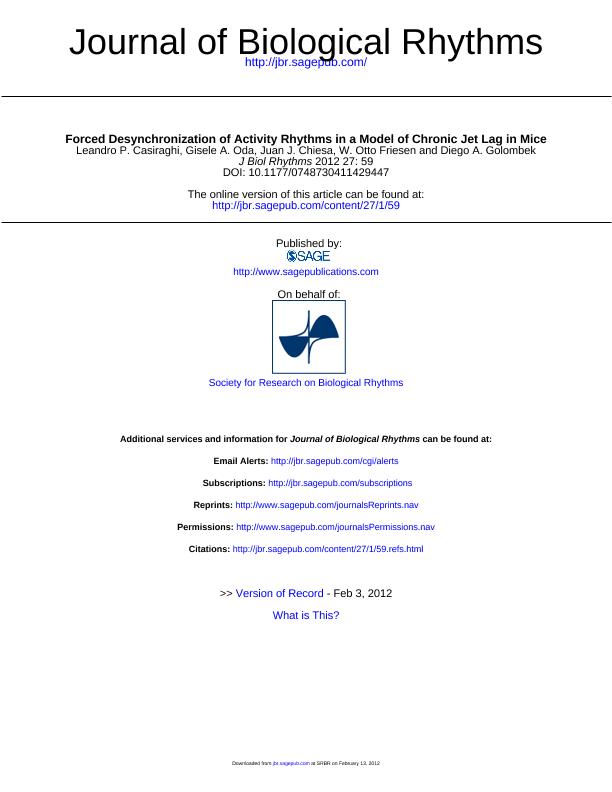Mostrar el registro sencillo del ítem
dc.contributor.author
Casiraghi, Leandro Pablo

dc.contributor.author
Oda, Gisele A.
dc.contributor.author
Chiesa, Juan José

dc.contributor.author
Friesen, W. Otto
dc.contributor.author
Golombek, Diego Andres

dc.date.available
2023-04-21T11:05:44Z
dc.date.issued
2012-02
dc.identifier.citation
Casiraghi, Leandro Pablo; Oda, Gisele A.; Chiesa, Juan José; Friesen, W. Otto; Golombek, Diego Andres; Forced Desynchronization of Activity Rhythms in a Model of Chronic Jet Lag in Mice; SAGE Publications; Journal of Biological Rhythms; 27; 1; 2-2012; 59-69
dc.identifier.issn
0748-7304
dc.identifier.uri
http://hdl.handle.net/11336/194851
dc.description.abstract
We studied locomotor activity rhythms of C57/Bl6 mice under a chronic jet lag (CJL) protocol (ChrA6/2), which consisted of 6-hour phase advances of the light-dark schedule (LD) every 2 days. Through periodogram analysis, we found 2 components of the activity rhythm: a short-period component (21.01 ± 0.04 h) that was entrained by the LD schedule and a long-period component (24.68 ± 0.26 h). We developed a mathematical model comprising 2 coupled circadian oscillators that was tested experimentally with different CJL schedules. Our simulations suggested that under CJL, the system behaves as if it were under a zeitgeber with a period determined by (24-[phase shift size/days between shifts]). Desynchronization within the system arises according to whether this effective zeitgeber is inside or outside the range of entrainment of the oscillators. In this sense, ChrA6/2 is interpreted as a (24 - 6/2 = 21 h) zeitgeber, and simulations predicted the behavior of mice under other CJL schedules with an effective 21-hour zeitgeber. Animals studied under an asymmetric T = 21 h zeitgeber (carried out by a 3-hour shortening of every dark phase) showed 2 activity components as observed under ChrA6/2: an entrained short-period (21.01 ± 0.03 h) and a long-period component (23.93 ± 0.31 h). Internal desynchronization was lost when mice were subjected to 9-hour advances every 3 days, a possibility also contemplated by the simulations. Simulations also predicted that desynchronization should be less prevalent under delaying than under advancing CJL. Indeed, most mice subjected to 6-hour delay shifts every 2 days (an effective 27-hour zeitgeber) displayed a single entrained activity component (26.92 ± 0.11 h). Our results demonstrate that the disruption provoked by CJL schedules is not dependent on the phase-shift magnitude or the frequency of the shifts separately but on the combination of both, through its ratio and additionally on their absolute values. In this study, we present a novel model of forced desynchronization in mice under a specific CJL schedule; in addition, our model provides theoretical tools for the evaluation of circadian disruption under CJL conditions that are currently used in circadian research.
dc.format
application/pdf
dc.language.iso
eng
dc.publisher
SAGE Publications

dc.rights
info:eu-repo/semantics/openAccess
dc.rights.uri
https://creativecommons.org/licenses/by-nc-sa/2.5/ar/
dc.subject
CHRONIC JET LAG
dc.subject
CIRCADIAN DISRUPTION
dc.subject
ENTRAINMENT
dc.subject
LOCOMOTOR ACTIVITY RHYTHMS
dc.subject
MATHEMATICAL SIMULATIONS
dc.subject
OSCILLATOR MODEL
dc.subject
SHIFT WORK
dc.subject.classification
Biología

dc.subject.classification
Ciencias Biológicas

dc.subject.classification
CIENCIAS NATURALES Y EXACTAS

dc.title
Forced Desynchronization of Activity Rhythms in a Model of Chronic Jet Lag in Mice
dc.type
info:eu-repo/semantics/article
dc.type
info:ar-repo/semantics/artículo
dc.type
info:eu-repo/semantics/publishedVersion
dc.date.updated
2023-04-20T16:07:04Z
dc.journal.volume
27
dc.journal.number
1
dc.journal.pagination
59-69
dc.journal.pais
Estados Unidos

dc.description.fil
Fil: Casiraghi, Leandro Pablo. Universidad Nacional de Quilmes. Departamento de Ciencia y Tecnología. Laboratorio de Cronobiología; Argentina. Consejo Nacional de Investigaciones Científicas y Técnicas; Argentina
dc.description.fil
Fil: Oda, Gisele A.. Universidade de Sao Paulo; Brasil
dc.description.fil
Fil: Chiesa, Juan José. Universidad Nacional de Quilmes. Departamento de Ciencia y Tecnología. Laboratorio de Cronobiología; Argentina. Consejo Nacional de Investigaciones Científicas y Técnicas; Argentina
dc.description.fil
Fil: Friesen, W. Otto. University of Virginia; Estados Unidos
dc.description.fil
Fil: Golombek, Diego Andres. Universidad Nacional de Quilmes. Departamento de Ciencia y Tecnología. Laboratorio de Cronobiología; Argentina. Consejo Nacional de Investigaciones Científicas y Técnicas; Argentina
dc.journal.title
Journal of Biological Rhythms

dc.relation.alternativeid
info:eu-repo/semantics/altIdentifier/url/https://journals.sagepub.com/doi/10.1177/0748730411429447
dc.relation.alternativeid
info:eu-repo/semantics/altIdentifier/doi/http://dx.doi.org/10.1177/0748730411429447
Archivos asociados
